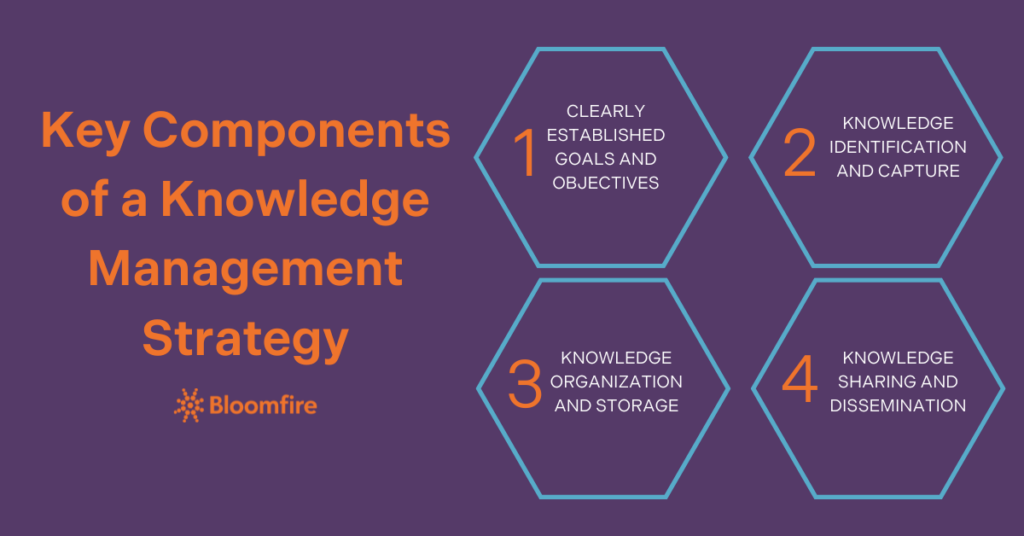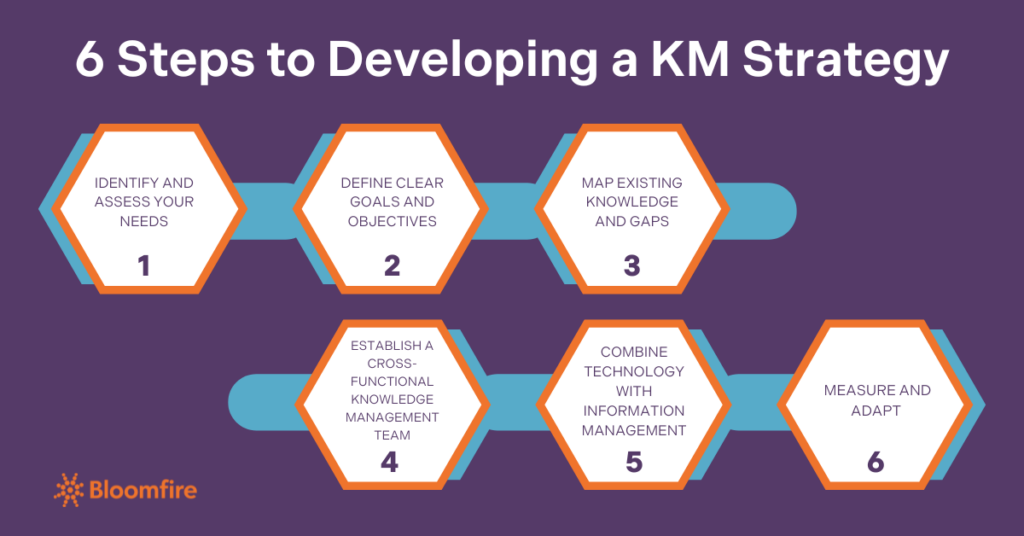Knowledge Management Strategies in 2025: Value, Key Components, and Development

Implementing a comprehensive knowledge management strategy is pivotal for any organization aiming to harness its intellectual capital effectively. But what constitutes an effective knowledge management strategy, and how can it catalyze organizational growth and efficiency? This post delves into the importance, components, benefits, and practical steps to formulate a strategic approach to knowledge management.
Highlights
- A practical knowledge management strategy transforms organizational operations by converting expert knowledge into a collective, accessible intellectual asset.
- Successful KM strategies require clearly defined goals, effective knowledge capture and organization, and robust sharing mechanisms to avoid inconsistencies and apathy.
- You can develop a KM strategy by assessing needs, setting goals, auditing knowledge, building a team, using technology, and continuously improving.
- Best practices for KM strategy implementation include customization, ensuring leadership support and collaboration, providing incentives, and promoting continuous improvement for a dynamic knowledge ecosystem.
What Is a Knowledge Management Strategy?
A knowledge management (KM) strategy outlines a comprehensive plan for centralizing, managing, and leveraging organizational knowledge to boost productivity and efficiency. This involves identifying critical knowledge assets and establishing processes for capturing and storing them (e.g., using knowledge bases, wikis, or document management systems). It also covers defining mechanisms for sharing and applying this knowledge.
A practical knowledge management strategy reshapes how an organization operates. It turns individual knowledge into a collective asset, ensuring that valuable insights, data, and information are preserved and made accessible, enhancing organizational learning and adaptability. It also aims to break down information silos, facilitate seamless collaboration through platforms like enterprise social networks or collaborative document editing.
Elevate Your KM Strategy
Discover how Bloomfire’s advanced tools unify insights and boost productivity.
See Bloomfire In Action
Examples of Knowledge Management Strategies
Knowledge management strategies manifest in various ways. An example of a knowledge management strategy following the current KM trends is utilizing technology like AI-powered search tools to improve information retrieval. According to Deloitte, out of the companies they surveyed, 67% report experiencing productivity improvements of 10% or more with automation.
However, it’s important to remember that strategies need not be grand immediately. They can start with small, doable actions, such as recognizing all types of knowledge, building a business case, and ensuring there is an executive sponsor to drive the strategy forward. A knowledge management strategy example to consider could involve a company implementing a centralized knowledge hub to facilitate easier access to corporate information and expertise.
The Importance of a Knowledge Management Strategy
Integrating a company-wide knowledge management strategy ensures that the organization’s goals are aligned with the systematic gathering, sharing, and management of knowledge. Despite implementing knowledge management systems, IDC research indicates that only 45% of employees in large organizations actively use them, highlighting the critical need for a robust KM strategy to ensure adoption and optimize the return on investment.
Additionally, a robust knowledge management strategy prevents the loss of critical knowledge, reduces redundant efforts, and fosters innovation by promoting collaboration and exchanging ideas. Specifically, a well-devised KM strategy offers these fundamental benefits:
- Increased efficiency: Streamlining access to information and expertise saves time and reduces redundant efforts.
- Improved decision-making: Access to diverse insights and data supports better, more informed decisions.
- Enhanced innovation: Sharing knowledge across boundaries fosters an environment ripe for innovation.
- Better onboarding and training: New hires can quickly come up to speed by accessing a rich knowledge repository.
Ultimately, deploying a robust KM strategy yields a more agile, responsive, and forward-thinking organization. A culture of continuous learning and information dissemination empowers employees, strengthens the business foundation, and positions the company for sustained success.
Key Components of a Successful Knowledge Management Strategy
Not all KM strategies are created equal. Some can fulfill their purpose with minimal roadblocks, while others go down the drain due to pitfalls like a lack of consistency, communication issues at work, and apathy regarding knowledge sharing. This is why it’s crucial to understand the major elements of an effective KM strategy as they lay down the roadmap for your execution. These components include the following:
- Clearly established goals and objectives: A successful strategy starts with outlining what the organization aims to achieve. This includes identifying knowledge gaps, improving decision-making, enhancing innovation, and boosting efficiency.
- Knowledge identification and capture: This involves pinpointing crucial knowledge assets within the organization. It includes identifying all the types of knowledge (explicit, implicit, and tacit) that exist across the organization. Effective methods for capturing this knowledge, such as interviews, document analysis, and knowledge mapping, are essential.
- Knowledge organization and storage: Once captured, knowledge needs to be organized and stored to make it easily accessible. This may involve using knowledge repositories, databases, intranets, or other digital platforms. Effective classification and tagging systems are crucial for efficient retrieval.
- Knowledge sharing and dissemination: The value of knowledge lies in its accessibility and application. This component focuses on a sharing knowledge strategy through various channels, such as communities of practice, online forums, training programs, and mentorship initiatives.
Every organization is unique when setting out to implement a knowledge management strategy. However, ensuring that the core ingredients of the strategy are there reduces any chance that establishing a sustainable knowledge management process will be forfeited.

How to Develop a Knowledge Management Strategy
Building a knowledge management strategy from the ground up might seem daunting. However, breaking it down into smaller activities and identifying the right team members to help implement the strategy will make your initiative much more manageable. These often involve creating a detailed knowledge management strategy plan that outlines the actions required to achieve these objectives. Here’s where to start:

1. Identify and assess your needs
Start by documenting the challenges your organization is trying to address and how a KM strategy will help you resolve them. Examples might include:
- Knowledge lives in many different repositories. We need one central repository for company-wide knowledge.
- Employees waste hours per week trying to track down information. We need a searchable platform that reduces the time it takes to find information.
When employees leave the company or move to a new role, knowledge is lost. We need clear processes to have employees and subject matter experts document and share their knowledge.
2. Define clear goals and objectives
Once you know what challenges you’re trying to solve, you can start setting goals and objectives around them. Your goals should be SMART: specific, measurable, attainable, relevant, and time-bound. You should also determine your key performance indicators (KPIs). These metrics will help you measure your success. For example, if you have a goal around reducing the time employees spend searching for information, one of your KPIs might be the average hours saved per employee per month.
3. Map existing knowledge and gaps
Conduct a knowledge audit to identify all your organization’s knowledge assets, where they live, and who has access (consider bringing together a team to divide and conquer this project). This will help you identify current obstacles (e.g., inability to access certain assets when needed). Devise a plan to migrate assets to a centralized location and uncover knowledge gaps you need to fill through new content creation.
4. Establish a cross-functional knowledge management team
Identify stakeholders from different teams who understand the value of knowledge management and are interested in working cross-functionally to improve your company’s KM efforts. Make sure they have the bandwidth (and willingness) to commit to participating in your KM initiative, and then establish a regular cadence for the team to meet. Each meeting must be as productive as possible by assigning action items based on your goals.
5. Combine technology with information management
Technology plays a pivotal role in enabling effective knowledge management. It can make capturing, managing, and accessing knowledge easier, from cloud-based knowledge bases to AI-driven search tools. Enhancements like AI-powered enterprise search streamline finding relevant information, while AI chat functionalities offer conversational assistance, making knowledge discovery as intuitive as speaking with a colleague.
While focusing on technology to enhance knowledge management, it’s also essential to consider the broader information management strategy to ensure cohesive data handling and accessibility. For example, integrating a new document management system (technology) must accompany updated data retention policies and metadata standards (information management strategy) to ensure efficient retrieval and long-term accessibility.
6. Measure and Adapt
Establish KPIs to measure the impact of your KM initiatives. Regularly review these metrics and be prepared to adapt your strategy in response to feedback and changing organizational needs. This iterative process ensures that knowledge management remains aligned with strategic goals and continues to deliver tangible value.
Developing a knowledge management strategy requires a systematic approach. Implementing the steps mentioned above allows organizations to harness the collective intelligence of their workforce. These lead to a learning environment that empowers individuals and strengthens the organization.
5 Best Practices for Implementing Knowledge Management Strategies
If your knowledge management solution is focused solely on documenting and preserving information, then no, it isn’t enough. A corporate knowledge management strategy is most successful when it also establishes the following practices:
- Customize your approach: Organizations possess distinct operational structures, communication styles, and established norms. Therefore, tailoring your KM strategy to fit your organization’s unique needs and culture is essential. Remember that an approach that respects the organization’s identity fosters greater adoption and maximizes the value derived from its knowledge assets.
- Engage leadership: Secure executive sponsorship to drive the strategy forward and ensure alignment with organizational goals. Leaders championing the strategy demonstrate its importance to the entire organization. This commitment facilitates the seamless integration of knowledge management practices into existing workflows and strategic objectives.
- Encourage cross-functional collaboration: Encourage teams to share knowledge and collaborate on cross-departmental projects. This allows for the dissemination of diverse perspectives and expertise, leading to more innovative solutions. It also strengthens internal networks, facilitating quicker problem-solving and improved efficiency.
- Incentivize participation: Recognize and reward contributions to the knowledge base to encourage ongoing participation. Acknowledging and incentivizing individuals who share their expertise fosters a culture where knowledge dissemination is crucial for mobilization. It cultivates a sense of ownership over the collective knowledge, prompting employees to actively engage in its growth.
- Promote continuous improvement: Knowledge management is an ongoing process. Regularly review and update your strategy to reflect changing organizational needs and technological advancements. These practices ensure that the knowledge environment remains dynamic and relevant to support evolving business challenges.
Organizations prioritizing alignment, culture, technology, governance, and measurement cultivate a thriving knowledge ecosystem. When implemented cohesively, these five practices empower employees, drive innovation, and solidify a competitive edge.
Frequently Asked Questions
What is strategic knowledge management?
Strategic knowledge management involves aligning an organization’s knowledge assets with its business goals. It focuses on creating, sharing, and utilizing knowledge to gain a competitive advantage. It’s about ensuring the correct knowledge is available to the right people at the right time to support strategic decision-making.
What is the most essential element in a knowledge management strategy?
While knowledge management strategies involve many elements, the most important is fostering a culture of knowledge sharing. Without engaged people, processes and technology will be underutilized. However, remember that a successful strategy hinges on people’s willingness and ability to contribute and utilize knowledge.
What is the KM strategy implementation plan?
A KM strategy implementation plan is a structured roadmap outlining the steps to put a knowledge management strategy into action. It details specific activities, timelines, responsibilities, and resources needed to achieve the desired knowledge-related goals. This plan ensures a systematic approach to deploying KM initiatives and measuring their effectiveness.
Optimize Your Knowledge Management Strategy
Supercharging your KM strategy becomes a grueling task without using an intuitive knowledge management platform like Bloomfire. With features like robust search capabilities, AI-powered recommendations, and collaborative workspaces to streamline knowledge sharing and creation, you can create a single source of truth for the organization. Combining this essential technology with the strategy implementation process mentioned above, you can set a clear roadmap for your knowledge management initiatives and fuel enterprise intelligence utilization effectively.
Ready to Transform Your KM?
See how Bloomfire turns your KM strategy into a competitive advantage.
Schedule a Demo
7 Proven Strategies on How to Improve Collaboration in an Organization

The Importance of Knowledge Management in Banking

Start working smarter with Bloomfire
See how Bloomfire helps companies find information, create insights, and maximize value of their most important knowledge.

Take a self guided Tour
See Bloomfire in action across several potential configurations. Imagine the potential of your team when they stop searching and start finding critical knowledge.
